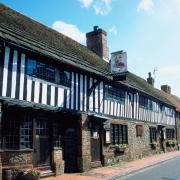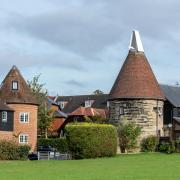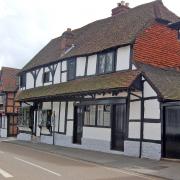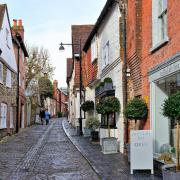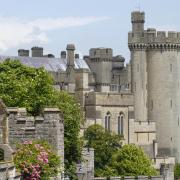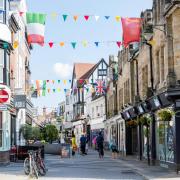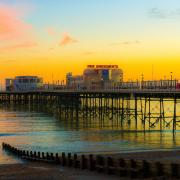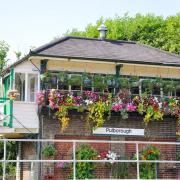Around 20 metres below the ground at South Heighton lies a secret tunnel devoid of any activity, graffitied, overgrown and falling away. But only 70 years ago, this tunnel was a hive of human activity as one of the most advanced communication centres in Great Britain. Kerrina Gray investigates

This year marks the 75th anniversary of Neville Chamberlain’s declaration of war with Germany. By now, it is hard to imagine that many secrets from the time still remain, but the mysterious tunnels of South Heighton are still relatively unknown.
The story of the tunnels began at Guinness Trust Holiday Home, standing majestically on Heighton Hill and providing inexpensive holiday accommodation for working class families. On 20 June 1940, the building was requisitioned by The Senior Service and was to become the root of a spiralling project to be named HMS Forward. Inside, it became responsible for HMS and naval offices across Eastbourne, Newhaven, Hove, Shoreham and Littlehampton. With such a complex inside one Holiday Home, it was decided that better security was needed for the communications equipment used for intelligence gathering, interpretation and dissemination. Therefore the decision was taken to start building down. Eventually, 10,000 naval staff would appear on HMS Forward’s records. More than 100 steps led the way down into an impenetrable fortress that contained the most sophisticated and contemporary communications devices available. Under the Emergency Powers Act for the Defence of the Realm, the tunnel would not be recorded with Land Registry and would remain a mystery for many more years to come. As a seven-year-old boy in 1941, Geoffrey Ellis walked to and from school along the B2109 just north of Newhaven. One day he was intrigued to find the Royal Engineers had arrived and started digging a tunnel into the bank by Heighton Hill. Following months of failed attempts to get the sentries that guarded the entrance to let him peek around the tunnels, Geoffrey had no idea that this would mark the start of his life’s work. When he finally got to enter the tunnels in 1946 after peace had been declared, it was “like my own personalised adventure story that eclipsed everything that I had ever read that was penned by Enid Blyton. It was an adventure into the unknown where even our footsteps echoed in the unearthly silence.”
Naval message pads and rolls of teleprinter paper littered the floor, a real sign of the activity that had filled the tunnels only one year before. After this visit Geoffrey had an “obsession” which would last a lifetime. “During my career with GPO Telephones, I discovered many clues that I realised were relevant to any later investigations I might involve myself with, such as old wartime papers and diagrams, and discussions with some of my elders.”
Geoffrey set about finding further information about the tunnels. He made appeals to the community and they responded with greater gusto than he could have imagined, providing carefully preserved autograph books, photo albums and other paraphernalia. He never expected where his research would take him. Like something out of a James Bond film, he was even phoned by an Imperial War Museum executive who told him he didn’t know what he was talking about.

“He insisted that the only military tunnels at Newhaven were those beneath the fort! He knew that for certain because he had researched and written a thesis
about all the military tunnels along the entire South Coast after the war. I took the greatest pleasure in informing him that he had missed this one and I could prove my case by providing as many photographs as he could want!”
The tunnels were principally staffed by teenage women who had just left college. They had volunteered to join the Women’s Royal Naval Service (WRNS or the Wrens) and were sent to HMS Forward to replace men who could then serve on the high seas in active duty. Throughout the war they maintained a comprehensive maritime surveillance of everything that moved on, under, or over the English Channel from Dungeness to Selsey Bill. In Geoffrey’s book The Secret Tunnels of South Heighton, he documents the response of WRNS Nancy Longstaff, who responded to his appeals from her home in Ormond Beach, Florida. She remembered: “I went to the tunnel in Denton as a nineteen-year-old Signals Wren from February 1944, to July 1945, working in the Signals Distribution Office. “The conditions were poor, no food provided, just facilities for making cups of tea. Young ones today wouldn’t work like we did for little pay.”
WRNS Violet Bedwell, who worked as a telephonist, seemed to agree with Nancy, describing the conditions as “working in the bowels of the earth”.
Nancy recalled one poignant incident: when logging teleprinter messages information arrived concerning the crew blown up at Ostende. A Petty Officer aboard was the husband of a woman in the Auxiliary Territorial Service serving in the tunnel at the time. He had been killed, but the Navy did not tell her until three days later. Nancy recalled how awful it was working alongside the woman, with them knowing and her not for three full days. On the most important day of WWII, Tuesday 6 June 1944, the WRNS and the secret tunnels would play an imperative role. Joined by members of the RAF, Women’s Auxiliary Air Force and the Auxiliary Territorial Service, they would monitor the marine traffic as it assembled and crossed the Channel on D-Day, helping to co-ordinate one of the biggest military operations in history.
When something which changed the course of the war lies metres below your feet, why is it that so few of us know that these tunnels and women even existed? “This labyrinth was designed and executed by the Royal Engineers on behalf of the Royal Navy under the most secret circumstances dictated by the Defence of
the Realm regulations,” says Geoffrey Ellis. “Until English Heritage carried out a pin-point digital survey of the tunnels at the request of the Friends of HMS Forward, the precise location of the tunnels relative to the surface structures was unknown. To this day, the tunnels remain unregistered and therefore fail to appear on any title deeds.”
He believes: “The biggest achievement of HMS Forward is undoubtedly to maintain its secrecy both nationally and internationally.”
Tony Helyar, Secretary of the Newhaven Maritime Museum & Historical Society, adds: “At the end of the war, all official records were destroyed, the tunnels’
existence remained a secret and were forgotten until their rediscovery in 1992.”
Now, the only real sign of the tunnels is a granite commemorative plaque above the fireplace in the main hall at Denton House. On it is carved a crown flanked by the dates 20 June 1940 and 31 August 1945. This year, Denton Community Primary School is recognising the work of the tunnels with a project. The children created a newspaper and film which they hope will be available as a learning resource for other school children who have an interest in the tunnels. Eleven-year-old student Alex Lowton really enjoyed taking part in the project. “I was amazed that plans for the D-Day landing were made inside the tunnels. We have learnt a lot!” he said.
Guy Walsh, Deputy Headteacher, said: “I think it is really important for people to know about their own heritage and it should be celebrated. The tunnels are in serious danger of completely collapsing and being lost forever.”
***
Getting there
• The postcode for your satnav is BN9
• South Heighton is on the A26
• The nearest train station is in Newhaven, which has trains that run in and out of London
--------------------------------------------------
Read on








